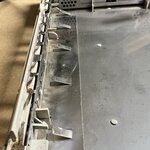As a side work of my rebuilding of the Macintosh 512K, I ended up recreating the RFI shields for the 512K.
Then, I thought I should do it for all early compact Macs, like the 128K, 512K, Plus and SE, SE/30.

I have one good condition RFI shied for the Mac Plus - so I started with the recreation with that RFI shield.
First, I did a hand-drawn copy of the shield, scanned it, and recreated it in Pages with simple shapes like circles and lines. The mouse connector's (D-Sub 9) outer shape was the most complicated shape. From that, I quickly created the Floppy connector shape, and of course, the SCSI D-Sub 25 was also "easy".
The original sheets I own are made of a 0.2 mm aluminium sheet. I was lucky; I could order a 50x50cm 0.2mm thin aluminium sheet board.




When it arrived, I cut a roughly identical size from the complete (50x50 cm).






Then, I used a cutter and a tool to cut out the round and straight lines from the metal.
You see the first prototype in the pictures - later, I studied how to cut this thin aluminium sheet with the knife.
The good point about working with this thin sheet is that the aluminium is flexible enough to be able to correct it - make it look nicer - if you make mistakes or imprecisely cut the edges.

I used this tool from the OBI hardware store to cut the holes and the round edges of the connectors. This is a cheap belt-hole puncher, but it worked well!

Finally, I cut and fixed the cardboard to the backside to protect the logic board from getting touched by the aluminium RFI shield.


You can download the 128K & 512K, the 512K, the Plus and the SE & SE/30 shield drawings:
Macintosh 128K & 512K - RFI Shield 805-0577 REV D.pdf
Macintosh 512K - RFI Shield 805-0583 REV B.pdf
Macintosh Plus - RFI Shield 805-5047-04.pdf
Macintosh SE & SE/30 - RFI Shield 805-5060-E.pdf
Then, I thought I should do it for all early compact Macs, like the 128K, 512K, Plus and SE, SE/30.
I have one good condition RFI shied for the Mac Plus - so I started with the recreation with that RFI shield.
First, I did a hand-drawn copy of the shield, scanned it, and recreated it in Pages with simple shapes like circles and lines. The mouse connector's (D-Sub 9) outer shape was the most complicated shape. From that, I quickly created the Floppy connector shape, and of course, the SCSI D-Sub 25 was also "easy".
The original sheets I own are made of a 0.2 mm aluminium sheet. I was lucky; I could order a 50x50cm 0.2mm thin aluminium sheet board.
When it arrived, I cut a roughly identical size from the complete (50x50 cm).
Then, I used a cutter and a tool to cut out the round and straight lines from the metal.
You see the first prototype in the pictures - later, I studied how to cut this thin aluminium sheet with the knife.
The good point about working with this thin sheet is that the aluminium is flexible enough to be able to correct it - make it look nicer - if you make mistakes or imprecisely cut the edges.
I used this tool from the OBI hardware store to cut the holes and the round edges of the connectors. This is a cheap belt-hole puncher, but it worked well!
Finally, I cut and fixed the cardboard to the backside to protect the logic board from getting touched by the aluminium RFI shield.
You can download the 128K & 512K, the 512K, the Plus and the SE & SE/30 shield drawings:
Macintosh 128K & 512K - RFI Shield 805-0577 REV D.pdf
Macintosh 512K - RFI Shield 805-0583 REV B.pdf
Macintosh Plus - RFI Shield 805-5047-04.pdf
Macintosh SE & SE/30 - RFI Shield 805-5060-E.pdf

